45 mobile app usage statistics to grow your user engagement in 2023
The news contents the Source of the article and credits to Amity

When was the last time you spent more than an hour or two without your smartphone? These incredible mobile devices are at the core of every human activity, our constant companion as we navigate the world, go about our business, unwind, and have some fun. Just as important as smartphones are the apps that exist within them.
The market is super saturated with an endless sea of apps distracting users on a daily basis. How can you engage users in an ever-changing landscape and ensure that they use your app? We’ve listed 45 mobile app usage statistics to help define your user engagement strategy in 2023.
80.69% of the world population has smartphones according to a recent study. This means there are 6,378 billion smartphone users around the globe. In 2021 alone, 230 billion apps were downloaded. People have dozens of apps installed on their mobile devices at any given time, but they only use a few of them on a daily basis. So it goes without saying that the app market is huge, and understanding mobile app usage is crucial in making your app stand out from the competition.
This article will focus on the two main mobile operating systems that dominate the market: Android and iOS. The data here is truly fascinating. Android has more devices, more apps, and more downloads. But statistics show that apps on the Apple App Store outperform apps on the Google Play Store when it comes to revenues. Understanding these two platforms will help your app succeed. But you also need to understand user behavior to tailor your app to meet the expectations of the customers. You need to have the correct user acquisition strategy as part of your marketing efforts. And you need to look at the mistakes other app developers are making to learn valuable lessons.
Here are the main categories we’ll be covering in this article on mobile app statistics:
1. Basic app usage statistics you need to know
2. App revenue statistics: What are people spending?
3. Useful information on app monetization
4. Key Google Play Store (Android) statistics
5. Key Apple App Store (iOS) statistics
6. A closer look at rising app categories
7. Social is trending, here are the hottest stats
8. Understanding audiences & consumer habits
9. User acquisition facts to give you a competitive edge
10. Learning from mistakes: how & why apps lose users
Basic app usage statistics you need to know
1 – A total of 230 billion apps were downloaded in 2021
The first mobile app usage statistic you need to know is how many apps are actually downloaded. In the last year alone, 230 billion apps were downloaded by users globally. That’s a 63% increase from 2016 when 140.7 billion apps were downloaded. We don’t have the data for 2022 yet, but we can tell you that 37 billion apps were downloaded in Q1 2022, 11% more than 2021. So the idea that the pandemic boosted app downloads is true, but it appears the trend isn’t slowing down any time soon.

2 – On average, people have 40 apps installed on their smartphones
With so many apps being downloaded, it’s good to know how many apps people actually keep on their phones. The average person has 40 apps installed on their smartphones, but they only use 18 of these apps on a regular basis. This number does change by age group. Millennials generally have more than 67 apps installed on their phones, but commonly only use 25. Keep in mind that when looking at these statistics, the apps installed decrease as the age group increases.
3 – A person typically uses 9 apps a day, and 30 apps a month
While it’s useful to know how many apps are downloaded and installed, the most important data is how many of these apps are actually used. Take a look at your phone right now and think of all the apps you have downloaded. How many do you actually use? On average, a person uses only 9 mobile apps a day, and 30 apps a month. Considering how many apps we have installed on our phones, it’s really interesting to see that we don’t even use half of them.
4 – Most popular app categories are: gaming, education & business
So what apps are people downloading and using on their Android and Apple devices? The most popular Apple App Store categories (by share of available apps) are Games (12.68%), Business (10.35%), and Education (9.79%). This data is similar in the Google Play Store categories, with Games (13.63%), Education (10.41%), and Business (7.17%) leading the list.
5 – Popular apps account for less than 20% of usage time
It’s important to know which app categories are popular and which apps users are downloading around the globe. But this isn’t a very accurate representation of which apps are actually being used. According to one study, only 20% of app usage time was spent on the top apps of the countries examined, meaning users spent 80% of their time on other apps. So while big apps like Facebook and WhatsApp are featured prominently on the most popular apps lists, users are spending their time on other apps. A prime example of this could be the novel social media app BeReal. It has over 53 million downloads on both Google Play and Apple App Store, but new research suggests that only 9% of Android users are actually opening the app. Popularity is important for an app, but usage data matters more.
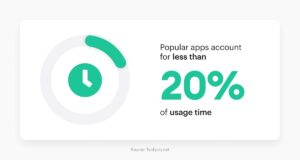
6 – Android has 2x apps available compared to Apple
Looking at the sheer volume of apps available, Android users can choose from 3.55 million apps on the Google Play Store. The Apple App Store only has around 1.6 million in Q3 2022. This data actually makes a lot of sense when you consider that it’s a much easier process to have your app accepted to the Google Play Store. The downside to this is that less feedback from Google Play means more buggy apps are available in the market which frustrates users, and there’s a lot more competition for Android apps compared to the Apple App Store.
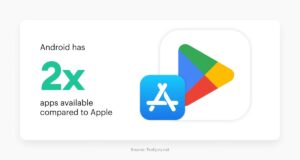
7 – Android gets more downloads (but Apple has more revenue)
This is perhaps the most interesting stat on this entire list: 27 billion apps were downloaded from Google Play in the third quarter of 2022. On the other hand, only 8.2 downloads were made in the Apple App Store during the same period. This makes sense, since there are more Android users, and more apps available in the Google Play store. So how is it that Apple generates more revenue with fewer apps and fewer downloads? Keep reading our list to learn more.
8 – The market share of mobile operating systems varies by region
The most popular mobile operating system changes by region, and these stats could surprise you. If you go into a shop and look at the smartphones available, there are more options available for Android devices compared to iOS. So it isn’t surprising that in Europe, Android has been the most popular operating system since 2013 with 67.21% market share as of 2021. But the market share of mobile operating systems begins to shift when looking at other regions. In the UK, iOS has 50.99% of the market share with Android following closely behind with 48% as of June 2022. The gap widens even more in the United States, with iOS at 60% and Android at 40% as of September 2022.
9 – Apps have higher conversion rates compared to mobile websites
Smartphones are more powerful than ever. There are many browsers to choose from, and most good websites are mobile-ready for a better smartphone experience. But data suggests that users are spending 7x more time in apps than in browsers. It makes sense that native apps enjoy higher conversion rates. Browsing a webpage isn’t engaging, and there are less features to capture the attention of audiences. Apps, on the other hand, come with a plethora of highly engaging features that inform, entertain, engage, and retain users.
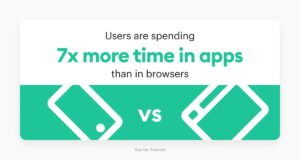
10 – Mobile traffic forecast is growing steadily
Advancements in technology have made us impatient. Gen-Z hasn’t even experienced the agony of waiting by your desktop computer for the dial-up connection to establish, or spending hours downloading one song off the internet on super slow speeds. Users want instant gratification, and the good news is, technology can provide that today (and even more in the future!) Mobile traffic is expected to continue growing in the near future with the emergence of 5G technology. Faster internet speeds will mean more data consumed. Monthly smartphone data usage is expected to increase from 10GB per person to 35GB by 2026. Apps need to keep up with growing internet speeds to retain users.
App revenue statistics: What are people spending?
11 – Google Play & Apple App Store revenues in 2022
First, let’s look at gross app revenue for both app stores. This consumer spending includes premium apps, subscriptions, and in-app purchases. Can you guess the winner? The gross app revenue in the Google Play Store in the third quarter of 2022 was approximately $10.4 billion. The Apple App Store, on the other hand, saw a gross app revenue of $21.2 billion. What’s fascinating about this data is that the Android market has much more apps and downloads than iOS. Yet Apple users spend twice as more on apps compared to Android users.
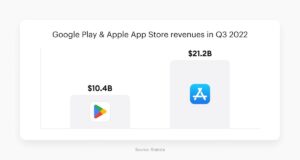
12 – Yearly mobile app revenue by segment, gaming in the lead
The global revenue of mobile apps surpassed $318 billion in 2020. This was a $60 billion increase compared to 2019. So which segments saw the most influx of cash? $200 billion of the $318 billion earned in the mobile app market came from the mobile games segment. Social networking apps, which are more present in the lives of average adults, made around $31 billion in 2020. Experts predict that all segments will see growth in revenues in the coming years, with the global gross revenue of the app market expected to reach $613 billion by 2025.
13 – Consumers spend more on mobile apps in Q4
So how much does the average person spend on apps? Let’s look at the quarterly data. In 2019 and 2020, the average was around $4 per smartphone. This increased to around $5 in 2021 and 2022. In this period of time, the average spending spiked to around $10 three times: Q4 2019, Q4 2020, and Q4 2021. This data clearly shows that users spend twice as much on apps in the last three months of the year.
14 – Quarterly consumer spending on mobile apps (it’s a lot!)
Individuals spending $4 to $5 on mobile apps per quarter may not sound too lucrative, but the numbers add up. In Q2 2022, the total global spending on mobile apps was $33 billion. This is $3 billion less than in Q2 2021. But the good news is, the average consumer spending on mobile apps is increasing each year, despite the fluctuations between quarters.
Useful information on app monetization
15 – In-app ads lead the way in-app monetization
Let’s face it, companies release apps to make money. So we had to include some crucial stats on app monetization to get a clearer picture of what’s going on in the app industry. How do apps make money? Looking at data from November 2022, we see that 26% of app revenue in the U.S. comes from in-app ads, which is slightly lower than the 37% global average. Paid apps perform better in the U.S. when it comes to revenue, but it’s still quite low at 8% in the U.S. compared to 3% worldwide. In-app billing is also higher in the U.S. with 11% of revenues, while the global average is at 4%.
16 – In-app ad market is expected to reach $312.48B by 2030
In-app ads generate a majority of the revenue in the mobile app market today. These include video advertisements, interstitial ads, and banner advertising. But the market is expected to grow even more in the future. An in-depth report by Market Research Future (MRFR) predicts that in-app advertising will reach a valuation of around $312.48 billion by 2030, with an impressive compound annual growth rate (CAGR) of over 17.32% in that period. In addition:
- The large number of free apps on the Google Play Store that generate revenue with in-app advertising means that Android will lead the market until 2030.
- Video ads will be the most prominent during this time, providing users with high-value content that is engaging and interactive.
- In-app ads will be utilized most by e-commerce and mobile shopping apps to improve click-through rates and ensure better targeting.
17 – Subscriptions generate the most revenue in non-gaming apps
Another widely popular method of app monetization is subscriptions. Looking at statistics from the U.S. collected in 2019, app subscriptions have the highest contribution to mobile revenues. An incredible 97% of consumer spending in the top 250 non-gaming apps in the Apple App Store came from subscriptions. Subscription-based revenue in the Google Play Store was 91%.
Key Google Play Store (Android) statistics
18 – Most popular categories in the Google Play App Store in 2022
In Q1 2022, there were more than 3.29 million apps available on the Google Play Store. Looking at these apps, the most popular categories in Q2 2022 were gaming (13.8%) and mobile education (10.47%). Over 96% of apps can be downloaded and installed on Android devices for free, without any upfront costs.
19 – Top Android apps in 2022 based on downloads are social
While the most popular categories are gaming and education, the most downloaded apps tell a completely different story about what users are consuming. The most downloaded app in the Google Play Store in September 2022 was TikTok, the popular short-form video-sharing platform. TikTok saw a good 24 million downloads during this period. The second most popular app was the social media platform Instagram, downloaded 21 million times on Android devices by users around the globe.
20 – Gaming leads top Android app revenues in 2022
How much money do apps make in the Android market? Let’s look at the Android app revenue data for September 2022. The most profitable app was the game Coin Master, which generated around $48 million in global revenue. The second app with the most revenue during this period was TikTok with over $40.6 million. Last but not least, Candy Crush Saga came in third with approximately $39 million in revenue in September 2022.

21 – Average price of Android Apps in 2022
We already mentioned that a majority of apps on Google Play are free to download (96%). How much do the paid apps cost? According to November 2022 data on app costs, 37,200 apps are priced at less than $1, followed by 29,000 apps priced at $1 to $2, and just over 2,000 apps priced between $9 and $10.
Key Apple App Store (iOS) statistics
22 – Most popular categories in the Apple App Store in 2022
In Q1 2022, there were 2.2 million apps available on the Apple App Store. Looking at these apps, the most popular categories in Q2 2022 were gaming (12.68%) business (10.35%), and education (9.8%). 94.2% of apps can be downloaded and installed on iOS devices for free, without any upfront costs.
23 – Top iOS apps in 2022 based on downloads are social
While the most popular categories are gaming, business, and education, the most downloaded apps are all in the social media category. The most downloaded app in the Apple App Store in September 2022 was the newest social media sensation BeReal with 13.9 million downloads, followed by TikTok with 7.5 million downloads. Social is the clear winner in downloads for both iOS and Android devices.
24 – Dating, gaming & social leads top iOS app revenues in 2022
How much money do apps make in the iOS market? Let’s look at the Apple app revenue data for September 2022. The most profitable app was the dating app Tinder, which generated around $37.6 million in global revenue. The second app with the most revenue during this period was the video-based social platform TikTok with over $35 million. Last but not least, the gaming app Honor of Kings came in third with over $24 million in revenue in September 2022.

25 – Average price of Apple Store apps in 2022
We already mentioned that a majority of apps on the Apple App Store are free to download (94.2%). How much do the paid apps cost? According to November 2022 data on app costs, the average app price on the Apple App Store is $0.88. iOS gaming apps, on the other hand, have an average price of $0.49.
A closer look at rising app categories
26 – Mobile shopping is on the rise & predicted to double by 2025
Retail e-commerce sales reached 359.32 U.S. dollars in 2021, increasing 15.2% from the previous year. E-commerce sales are expected to more than double in size and hit $728.28 billion by 2025. The upward trend prediction for mobile commerce is fueled by the sheer number of mobile device users, which is expected to reach 292 million people by 2024. It’s predicted that 187.5 million of these global mobile device users will shop using their smartphones.
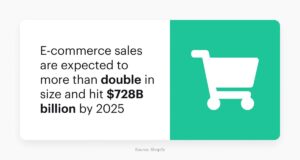
27 – 55% of internet users shop on their mobile phones
Mobile shopping is the norm for most of us. It’s so easy and quick to tap on an app and place an order these days. Experts also predict that the future of mobile shopping is bright when it comes to revenues. But what’s the data on consumers today? One 2021 research suggests that 55.4% of internet users shop online using their smartphones. 69.4% use shopping apps on their mobile devices to make purchases (that’s 7 in 10 people!)
28 – Global mobile gaming market to reach $338 billion by 2030
We’ve mentioned the impressive performance and unprecedented growth of the mobile gaming market several times on this list. This shouldn’t come as a surprise considering that there are billions of gamers around the world from all age groups, genders, and demographics. Committed gamers play daily and spend actual money on in-app purchases, so user engagement and app monetization opportunities are extremely high for mobile games. Let’s delve deeper into this extremely lucrative market and look at some mobile gaming projections for the future:
- The mobile gaming market size is expected to reach $338 billion by 2030.
- The compound annual growth rate (CAGR) during this period is expected to be 12.3%.
- iOS is projected to generate $171.38 billion by 2030, beating out Android.
- The largest market share by region is expected to be Asia-Pacific with $179 billion.
- North America’s revenue share is expected to reach $80 billion.
29 – Health & fitness apps are trending upwards
There’s no doubt that young people today are much more health-conscious compared to their parents and grandparents. They’re also more tech-savvy. As a result, it was only natural for health and fitness apps to find their way into the app stores. However, when the pandemic hit, this segment of the market experienced quite a large boom. In 2021, fitness apps generated $5.35 billion in revenue, which is 54% more than in 2020. 400 million fitness apps were downloaded in 2021 alone.
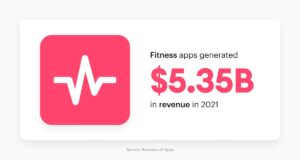
30 – Fintech apps are booming & here to stay
The pandemic led to a surge in fintech app use. We were stuck in our homes and needed ways to continue managing our finances. Outside, we had to socially distance ourselves and find new ways to make payments without cash. As a result, fintech apps reached 573.1 million downloads in the U.S. alone, increasing from 481.9 million the previous year (so around 19%). The use of cash has decreased by 42% since 2019, and 52% of purchases were made with a digital wallet in 2021. The fintech app market is growing quickly, and the data shows that it’s here to stay. The new buzzword in the app market is “super apps”, which are apps that provide multiple services in one place. Fintech apps are prime candidates to become super apps and they can achieve this by having a community-driven approach.

Social is trending, here are the hottest stats
31 – Understanding the key metrics of social media
We all know how important social media is, not just in regard to mobile app statistics, but in our actual daily lives. So if you’re developing an app, then you already know how important it is to be present on social media to promote your brand. But it goes beyond that. More and more apps are including social features to increase engagement and retention. To help you understand your customers better, we’ve compiled the top social media statistics you need to know:
- There are approximately 4.74 billion social media users in the world as of October 2022, equating to 59.3 percent of the total global population.
- Over the past year, 190 million new users joined social media.
- The average person spends 2 and a half hours a day scrolling social media, which amounts to 15% of the time we’re awake.
- The typical social media user visits an average of 7.2 social media platforms a month.
- Reasons for using social media: 47% of people use social media to keep in touch, 35.4% to pass free time, 34.6% to read the news, 26.2% finding products to purchase, 23.9% discussing opinions, 23.8% watching live streams. 21.7% finding like-minded communities, 21.2% posting about their lives, and 20.9% following influencers or celebrities.
- The top social media platforms: Facebook (2.934 billion monthly active users), YouTube (2.515 billion), WhatsApp (2 billion), Instagram (1.386 billion), WeChat (1.299 billion), and TikTok (1 billion).
- It’s also important to understand why people use specific social media platforms. Here ‘s a fantastic chart detailing social media activities by platform:
32 – Daily open rates of social apps might be lower than you think
So how often do users actually use social media platforms on a daily basis? According to Q2 2022 data, 40% of Instagram’s active users engaged with the app daily, 30% of TikTok’s users engaged daily, and less than 10% of Twitter users opened the app every single day. This shows us that while app downloads are important, what really matters is creating an app that people actually want to use on a daily basis.
33 – Daily social media engagement rates
Let’s look at the engagement data for the leading social media apps to better understand what users are seeking to consume on a daily basis. According to Q2 2022 data, TikTok had the most engagement with global users spending 95 minutes on the app per day. YouTube came second with global users spending 74 minutes in the app per day. Instagram came in third place with global users spending 51 minutes in the app per day. All of these platforms have one thing in common: short-form video content (TikTok videos, YouTube Shorts, and Instagram Reels).
Understanding audiences & consumer habits
34 – Smartphone use is an addiction
There’s no easy way to say this: We’re addicted to our smartphones. We know this from personal experiences, but there are plenty of research and statistics that support this as well. Did you know that the average American checks their phone every 4 minutes? Totaling 2 hours and 54 minutes on their phone each day? Which means we will have spent over a month of 2022 using our smartphones? Here’s some more data from the same research that illustrates the vitality of the mobile app market:
- 71% of people check their phones within 10 minutes of waking up.
- 70% check their phones within 5 minutes of getting a notification.
- 74% of people feel uneasy if they leave home without their phones.
- 48% of people feel anxious and panicked when their phone battery runs low.
- 35% of Americans look at their phones while driving.
Smartphone addiction doesn’t have to be a bad thing. If people are using their phones with meaning and purpose, they can have fulfilling lives online as well. This means that the apps we spend so much time on should help us learn, socialize, and grow. As an app developer, you can do this by adding new social features to your app that makes people excited to use your app while giving them a sense of belonging in a community.
35 – Most popular smartphone activities for global users 2021-2022
We’ve already established that app downloads don’t necessarily mean consumers are actually using the app. So the most crucial research to understand user habits is this survey on what activities consumers use their smartphones for conducted between July 2021 and June 2022. The number one spot was chatting and sending messages (76%). The third most popular mobile activity was listening to music. 61% of respondents said they used their mobile devices for banking. Again, 61% of respondents reported using their mobile devices to watch videos. Interesting to see that gaming, the most profitable category, is not on this list.

36 – Social, gaming & entertainment lead minutes spent in apps
How far does our social media addiction go? This research on time spent in apps is a very useful source to better understand consumer habits. Between October 2020 and March 2021, worldwide users spent 55.48 minutes on social media apps, 16,7 minutes on mobile gaming apps, and 13.53 minutes on entertainment apps.
37 – Most hours spent on social media & communication apps
Here’s another research on total hours spent on mobile apps worldwide to help you better understand user habits. 43% of users spent their time on social media and communication apps in 2021. 25.4% of users spent their time on photo and video apps. Even though it has the most revenue, gaming came in third place with only 7.7% of the time spent.
38 – Time spent on apps per country
It wouldn’t be too hard to guess which countries have the most mobile users based on population. But which countries spend the most time using mobile apps? Number one is Brazil with 5 hours and 26 minutes spent using mobile apps daily in 2021. Second place is Indonesia with 5 hours and 25 minutes. Third place is Germany, with 3 hours and 22 minutes spent on apps per day. Finally, users in China spent 3 hours and 10 minutes on mobile apps daily in 2022.
39 – Popular smartphone activities while watching TV
It’s time to delve deeper into the mobile app usage statistics of consumers. Watching TV used to be an activity on its own, but these days people tend to spend that time scrolling on their phones. One research from 2019 looked at the most popular activities of second-screen users in the United States, meaning the people who also use their smartphones while they watch TV. And the results are a useful insight into what people like to do from the comfort of their couches. The data also aligns with other studies that put communication and social media at the top of the list of mobile device activities.
- Responding to e-mails (76%)
- Social media (71%)
- Researching info on what’s on TV (68%)
- Playing games (55%)
- Online shopping (54%)
- Online banking (55%)
- Watching videos (43%)
- Reading the news (40%)
- Taking photos/selfies (33%)
- Ordering food (33%)
User acquisition facts to give you a competitive edge
40 – Best ad formats for mobile app user acquisition
User acquisition is one of the most important things on your to-do list when you launch an app, and there are several ways you can do this. Marketing is one of these crucial steps to acquiring new users for your app. One 2022 research surveyed app developers from around the world to determine the most effective ad formats for user acquisition. 51% of respondents picked full-screen video ads as the most effective format. In second place was social video ads with 46%. Third place went to in-feed video ads with 41%.
41 – Key targeting criteria for mobile app user acquisition
When running user acquisition ad campaigns, which targeting parameters are the most important? One survey from 2022 asked app developers, publishers, and marketers around the globe this question. 54% picked geography as the most important parameter. 52% identified the operating system of users as the most important criteria when targeting ad campaigns.
42 – Top pricing methods for mobile app user acquisition
When running ad campaigns to gain new users, pricing models are an important consideration. This survey of app developers, publishers, and marketers from 2022 delved deeper into this subject. The most used pricing model according to six in 10 respondents was cost per install. The second most used pricing strategy was cost per action, or CPA impressions, with 35% of respondents choosing this option for user acquisition.
Learning from mistakes: how & why apps lose users
43 – App churn rates & user retention are… not great
Yes, billions of apps are being downloaded every year. That’s great! But an app developer’s journey does not end there. Do users have a reason to use your app? Are you giving them engaging features to retain their attention? Is the UX design thoughtful and easy to use? Are there bugs causing issues for users? Are you spamming users with notifications and ads, causing them to uninstall your app completely? To put things into perspective, if your app takes too long to load, you’ll use 70% of your users. This shows just how picky app users are these days. They expect the best, and if you can’t provide that, they’ll find another app that can. So you need to have an excellent user retention strategy in place to ensure that your app performs well.
44 – A closer look at app retention rates for iOS & Android
App retention is one of the most important metrics you need to pay attention to once your app is live. Data from Q3 2021 indicates that iOS app retention was 25.65% after one day following the initial download and 4.13% after 30 days. Androd app retention, on the other hand, was 23.01% after one day following the initial download and 2.6% after 30 days. These statistics show us that downloads from the Apple App Store enjoy higher retention rates than downloads from the Google Play Store.
45. Understanding why users uninstall apps
To retain customers and ensure that they keep using your app, you need to understand why people uninstall apps. This survey of mobile app users asked this crucial question. The results show us that app developers need to be mindful of giving consumers features and content that are meaningful and engaging, being mindful of not spamming users with notifications and advertisements, and running the necessary software tests to ensure good app performance.
So why do users uninstall apps?
- 39% of users uninstall apps because they no longer use it
- 28% of users uninstall apps because of too many notifications & ads
- 20% of users uninstall apps because of limited storage space on their phones
Other factors that push people to uninstall apps include: a difficult sign-up princess, privacy concerns, high data usage, apps with high battery drainage, and issues with the app freezing. Users can also delete your app if they never use it, if they use it too much and want to prevent that, or if they download an app from a competitor.
Key takeaways to take into 2023
After seeing these key statistics, you should have a clearer picture of what you need to do for your mobile app to succeed in 2023. App development is a competitive field, and it doesn’t matter how good your app is from a technical standpoint if you don’t take the time to understand your users and try to provide them with engaging, enriching experiences. You need to strive for more downloads, but your job doesn’t end there. You need to capture the attention of your customers and give them quality content and features to ensure they keep coming back and using your app.